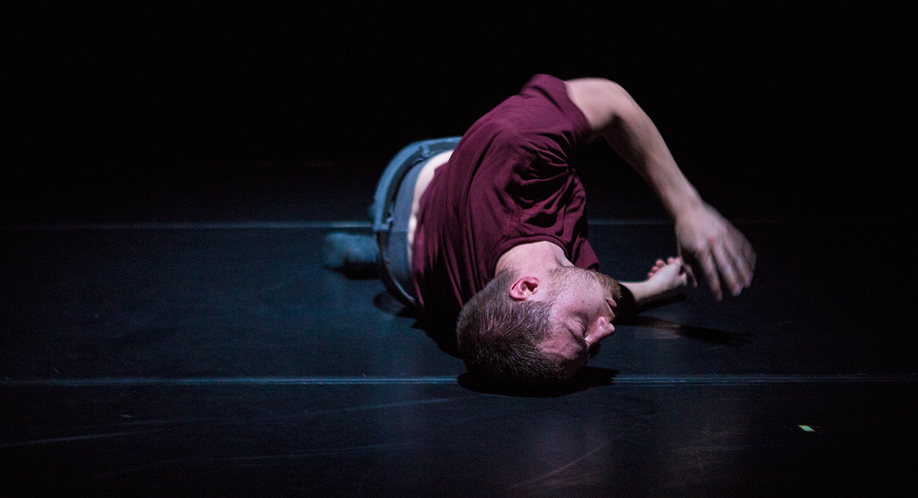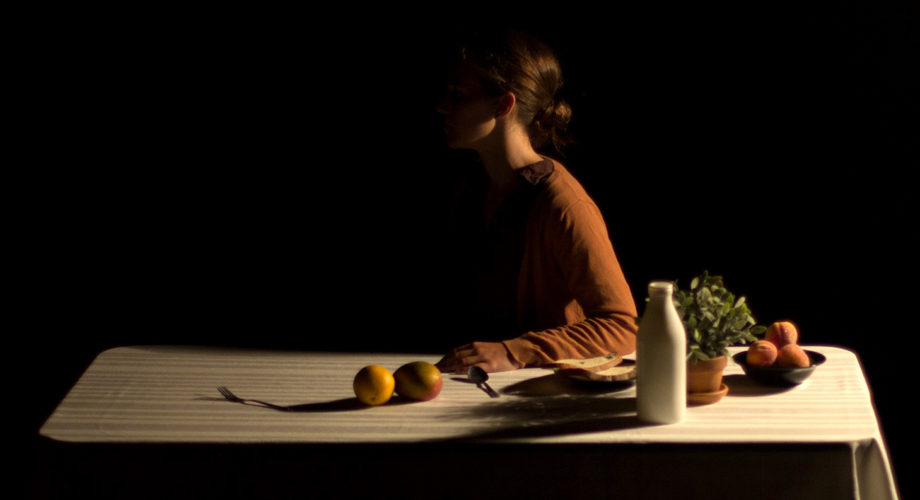Thurs Aug 15
-
-
Fri Aug 16
-
-
Sat Aug 17
-
-
Sun Aug 18
JOIN US FOR A POST SHOW CHAT:
Saturday August 17, 5:00 p.m. with Katia-Marie Germain and Josh Martin
Facilitated by Mimi Beck*

Josh Martin (Company 605)
Vancouver, British Columbia
Toronto Premiere
Content Warnings: Loud Music
This solitary dance began as an investigation surrounding an idea that the body holds a separate memory bank. Muscle tissue, bones, tendons and organs all storing their own accounts of past events, actions and trauma, with this collected information not readily shared or easily accessed by the mind. The process has been an exploration of how to consistently find, enter, and move through different states and sensations. In a constant effort to disconnect movement from thought, the dance is an attempt to externalize the inner moments of body recall, and an expansion of what gets churned up in the retrieval.
“Martin’s muscle isolation skills are amazing…(he) gives shape to the subconscious conflict between action and thought, and between past and present.”
– Ottawa Citizen
Choreography and Dance Artist: Josh Martin
Lighting designer: Won Kyoon Han
Music: Lightning Bolt / Polmo Polpo
Rehearsal Director: Lisa Gelley
Special Thanks: Barbara Bourget, Lee Su-Feh, James Proudfoot
Josh’s Headshot by David Cooper
Originally from Alberta, Josh Martin is a diversely trained dance artist now residing in Vancouver, on the traditional and unceded territories of the Coast Salish Peoples. He has worked with many creators such as Justine A. Chambers, Out Innerspace, Dana Gingras, Serge Bennathan, Vanessa Goodman, Wen Wei Wang, and as a member of Le Groupe Dance Lab (Ottawa). For over ten years, Josh Martin has been an Artistic Co-Director of Company 605, a Vancouver-based organization producing various dance projects, regularly creating and touring new collaborative works throughout Canada, and internationally in the USA, Central America, Europe, Japan and Australia. www.company605.ca.
Interview with Josh Martin by Grace Wells-Smith
Grace Wells-Smith: Tell me a bit about your piece.
Josh Martin: It was actually a solo that I created over a long period of time because I was forcing myself, after making a whole bunch of group work, to make a solo piece. It started, really, just with the idea that inside of my career I’d performed a lot of different works from a lot of different people and a lot of different types of movements. And I was curious about how my body might hold that information and how my body memory would be slightly different from what my actual brain’s memory of some of that stuff would be. It was about trying to access a bunch of material and ideas all at the same time and skipped around inside of what my body could recall. From that came more of an improvisation of states of trying to get into this place of recall and to bring up a lot of material and ways of moving and shapes and sensations that had occurred in the past … the choreography itself isn’t choreographed. There is really very little choreography inside of it. It’s improvised.
GWS: When you go into rehearsal, how do you start?
JM: I have music that I use that’s become the parameters of the work. When I was creating it, I was starting all types of different ways and I was searching out all types of different tasks to give myself. But now that I’m rehearsing it, it’s more about trying to remember certain sensations and trying to slot my body into a place where I’m not easily choosing what to do but letting that kind of happen.
GWS: Is your improvisation guided?
JM: The work follows a clear structure I’ve given myself. It’s not just a free for all. The guide is the music and the structure is how I’ve created different situations or the placement of the work onstage or how one task or one idea can flow into the next. So, there’s different ways of moving. There are transitions between one kind of improvised state versus another one. And I’ve been working on how to move through those different sensations and trying to merge them.
GWS: When you go to perform this, how will you get ready?
JM: This is a tough one because it’s a little bit different than other work where you want to rehearse and rehearse and rehearse and try and do it as many times over as possible. With this, now that I’ve performed it enough times, it feels like you almost want to leave it a little bit untouched so that when you go to access it, it feels a bit more rich and ready to pour out. I’ll do some body work in terms of accessing all different types of sensation. I’ll try and get my body prepared to be as elastic and adaptable as possible. But I don’t necessarily like to do a bunch of rehearsal of the actual solo itself. I kind of like to leave that as fresh as I can for each performance.
GWS: Is this the kind of solo that you think could ever be put onto another person, or could it only ever be done by you?
JM: That’s a really good question. It would obviously look very different, I think, on somebody else because it’s really based on their body. But I do think that I would be really curious to see somebody else take on the same premise, or if I was to be able to work with somebody and explain all the different approaches that I’m taking, or the methodology behind a lot of the different tasks that I’m performing. I think it’s totally feasible to put on somebody else and have a similar experience watching it. But it would just look very different, I think.

Katia-Marie Germain
Montréal, Quebec
Toronto Premiere
In a breakfast table setting illuminated by a single light source, Habiter explores the relationship between body and place, the resonance between bodies and objects. An aesthetic of chiaroscuro unveils a series of both strange and familiar actions that are punctuate by the intermittent movement of light, and which temporarily plunge the room into darkness. Playing with illusion and perception of time, the visible and invisible movements of the bodies quietly and subtly alter the visual space as if a painting is coming to life before our eyes. We are called on to pay close attention as the familiar becomes an increasingly strange fiction.
“Nearly solely a series of still images…which speaks of memories and disappearance, of the transmission of delicateness and its individuality. The work is solid and coherent.”
– Le Devoir
Choreographer, Scenographer and Sound Designer: Katia-Marie Germain
Dance Artists: Marie-Gabrielle Ménard, Katia-Marie Germain
Rehearsal Director and Artistic Advisor: Lucie Vigneault
Creation Support: Conseil des arts et des lettres du Québec, Conseil des arts de Montréal, Circuit-Est centre chorégraphique, La Briqueterie – centre chorégraphique du Val-de-Marne
Katia-Marie’s Headshot by Oliver Desjardins
Katia-Marie Germain is a Montréal-based choreographer and performer. She completed a BFA in Visual Arts (2007) and Dance (2010), as well as her MA in Dance at UQÀM (2017). Her works Y demeurer (2010), Aube (2012), FOLDS (2014) and Habiter (2017) were premiered in Tangente and performed in a reprise in various venues and festivals. She has received support from creation residencies in Montréal as well as international exchange programs in Belgium, Chile, France, and Italy. In November 2018, Katia-Marie was awarded the Montréal Prix DÉCOUVERTE de la danse in recognition for her singular interdisciplinary approach.
Entretien avec Katia-Marie Germain par Grace Wells-Smith
(English below)
GWS : Comment cette approche artistique est-elle différente de vos approches artistiques précédentes ?
KG : Dans ce projet, le rapport entre la danse et les arts visuels se présente de manière plus évidente que dans mes projets précédents. Le rapport à l’image devient tout aussi significatif que le rapport au chorégraphique, contribuant à créer une œuvre qui se situe à la frontière entre ces deux disciplines. La scénographie a également pris une place importante puisqu’elle a influencé tout le développement de la gestuelle.
GWS : D’où vient le titre ?
KG : Le terme Habiter réfère à l’intime relation entre le corps et le lieu qu’il occupe. Qu’est-ce que le lieu génère dans le corps et, inversement, comment le corps informe-t-il l’espace du lieu ? Ces questions ont constitué le point de départ de cette recherche.
GWS : Pouvez-vous expliquer comment le projet a été construit ? Aviez-vous des collaborateurs ?
KG : J’ai occupé dans ce projet plusieurs rôles, travaillant à la fois la chorégraphie, le mouvement, le son, la lumière et la scénographie. Cela a eu pour effet de renforcer une dynamique d’ensemble, une conversation où les éléments se complètent et se répondent. Cette façon d’aborder l’œuvre sous différents points de vue s’est présentée comme un vecteur d’inspiration, une façon d’élargir mon terrain de jeu créatif. J’ai d’abord été accompagnée par ma précieuse collaboratrice à l’interprétation Marie-Gabrielle Ménard, puis plus tard par la répétitrice et conseillère artistique Lucie Vigneault.
Interview with Katia-Marie Germain by Grace Wells-Smith
(Translated from French)
GWS: Can you speak to the specificity of your process in this piece compared to those previous?
KG: The interplay between dance and visual art is overt in this work, which truly sits at the intersection of artistic disciplines. The work’s relationship to image is as meaningful as its relationship to choreography. The set design also plays a big role, and it influenced our whole approach to movement.
GWS: Where does the title come from?
KG: The word habiter – to inhabit – refers to the intimate relationship between the body and the space it occupies. What does site generate within the body, and conversely, how does a body inform a space. The work emerged from these questions.
GWS: How did you build the work? Did you have collaborators?
KG: I took on many roles for this project, working on choreography, movement, sound, light and set design. The elements are in a conversation, responding to each other dynamically, so my investment in each of the parts reinforces the work’s cohesion. Approaching the work from these multiple perspectives inspired me and broadened my creative playground. I was initially supported by my precious dancer collaborator, Marie-Gabrielle Ménard, and eventually by Lucie Vigneault, rehearsal director and artistic advisor.
*About the Moderator
Mimi Beck is Dance Curator for DanceWorks, Toronto’s longest running dance presenting series which encourages the love and appreciation of dance in all forms. She is Executive Director and a Board Member of The CanDance Network, Canada’s national arts service organization for dance presenters. Beck has served as a juror and assessor for arts councils and foundations. She was named “One of 19 who made a difference in the arts” by The Toronto Star, honoured with a Dance Ontario Award (2007) and Harold Award (2006). Beck received the first Canada Council Grant given to a Dance Curator.
